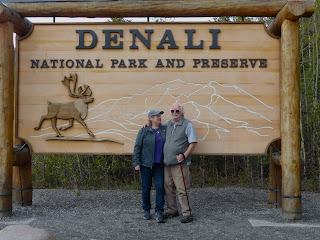We rode a park tour bus into Denali National Park and within the last couple of miles, near the stream below the road, we saw a grizzly digging for grubs and roots. The guide stopped the bus and we took photos. As the bear moved along the stream, we drove on a few hundred feet, stopped, and took more photos.
We stopped at the sign marking Sable Pass. The guide told us bears had eaten the old sign; this time rangers had installed spikes to discourage consumption.Alaskans call these grizzlies "Brown Bears" as opposed to Black bears, which also live in Alaska but generally not in the area where brown bears congregate. About 42 miles from the tourist center near where a landslide had closed the road, we stopped at the stream crossing, walked across a bridge to the port-a-potties, then reboarded and headed back to the tourist center. Along the way, we stopped again to photograph the bear, now closer to the bridge. Clouds prevented us from seeing Mount Denali.When we reached the visitors center, a loudspeaker announced that the bridge (and thus the port-a-potties) had been closed, because of the presence of a bear.Deb wanted to kayak and hike, so she took a water taxi to Peterson Bay where she and several others climbed into kayaks and paddled to Halibut Cove.
Along the way, she passed a farm stand—in a boat—selling oysters on the honor system. At the cove, she began the two mile hike to Gerwingk Glacial Lake, a 425-foot-deep lake carved into the mountain only in 1967 when a landslide created a mega tsunami. The first half mile of the hike was a killer, steep switchbacks, but the remainder was mostly level with a fine lake at the conclusion.While Deb kayaked, I and four others flew in a six-passenger Cessna across Cook Inlet for an hour and a half or so to look for bears. Much of the time, we flew in clouds that limited visibility, but the clouds continuously shifted, sometimes providing spectacular views of mountains and water. When we reached the west shore of Cook Inlet, the pilot circled the flats several times looking for a good spot for bears—there was perhaps one bear in every square mile or so—and finally settled the plane on the gravel beach. The oversize tires made the landing as smooth as if we were on a paved runway. We climbed out and walked over a berm at the top of the beach onto a grassy and watery flat. About a hundred yards away lay a brown bear.
We formed a tight
The hindfoot print is in front of the fore print which
is how they walk; the hindfoot is about the size of my boot
print.
We saw caribou, bulls with antlers in velvet, cows with calves.
In restaurants, we ate Reindeer meat. The Alaskans I asked about it claimed
Reindeer were farmed and a different animal than caribou; I could only think of
Santa and Rudolph. I can say: Reindeer
does not taste like chicken.
At one point, we thought we saw wolves some distance off the road.
We stopped and discovered they were twin moose calves scrambling to get out of sight.We saw Dall sheep high on a mountain.
And Mountain Goats, even higher.
As we sped along the paved Sterling highway to Homer, we spotted a cow moose just off the road on the edge of a gravel road. Our guide stopped the van, turned it around and we went back for a closer look. The moose ignored us.After shooting our fill of photos, we drove farther to find a turnaround, and discovered an enclave of Russian Orthodox churches. Dominating the area was the newest. Not far away, the oldest. Most interesting, however, were the structures in between: The Transfiguration of Our Lord Church (established in 1901) surrounded by wooden grave markers behind a decrepit picket fence.Although a few people wandered the graveyard, we were distracted by an eagle in a tree behind a bell structure. Then we discovered on the edge of the churchyard, a low tree, a nest,and an
Crew members netted small ice chunks and after showing one around—they said it was much denser than freezer ice—they chipped it up to serve in “iceberg margaritas.”
We stopped at Seavey dog kennels near Seward to see an Iditarod summer training facility. Since 1963, the Seaveys have been the preeminent Iditarod mushing family, winning eight Iditarod races—a family member holds the Iditarod speed record, covering 1049 miles by dog team in 8 days 3 hours 40 minutes and 13 seconds. As part of their summer training, the dogs pull wheeled carts weighing about two thousand pounds (before tourists climb on), pulling the carts along gravel paths through the woods. We took a turn. The dogs seemed happy and eager to pull. At the kennels, weand generally had a good time.






















































